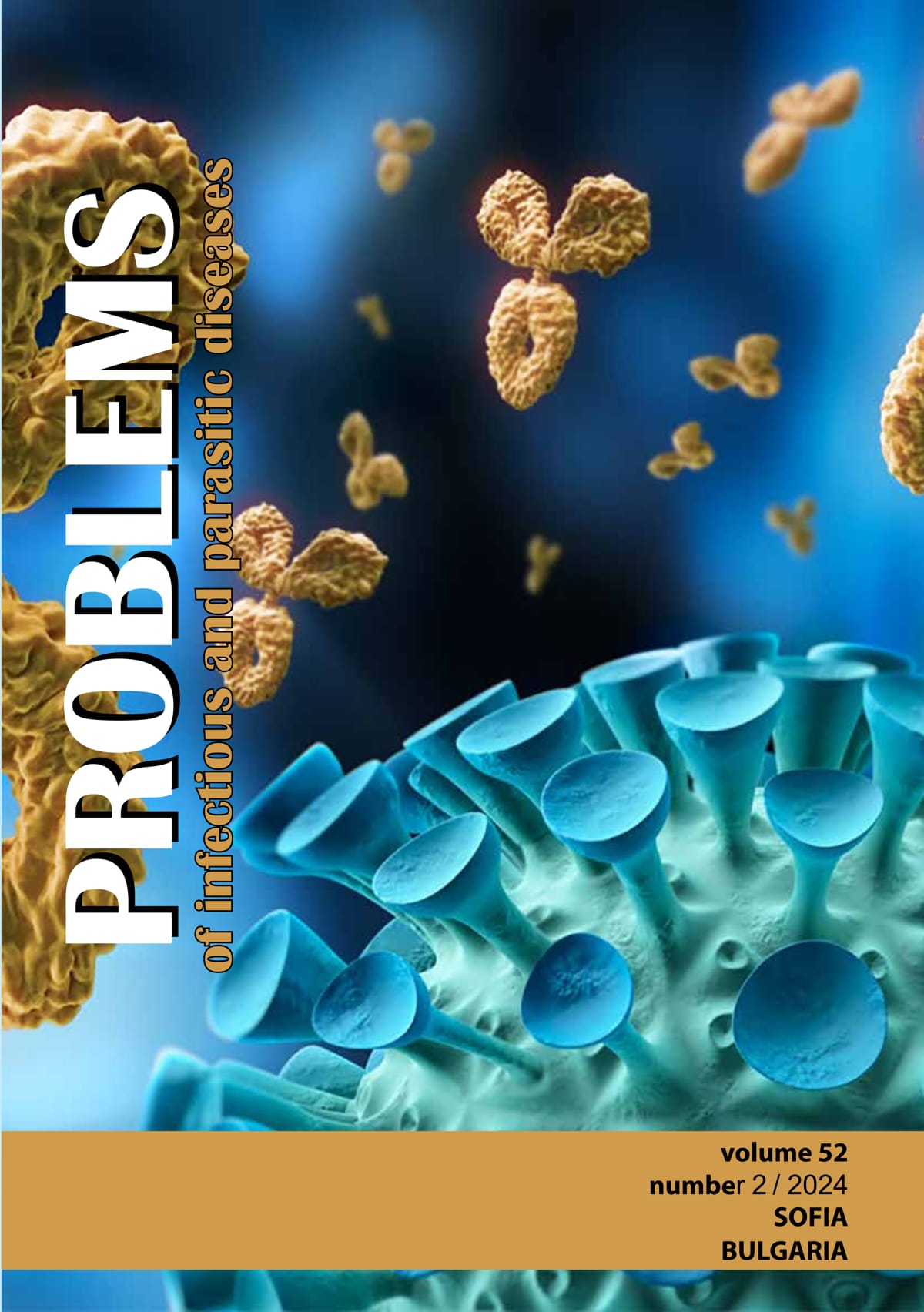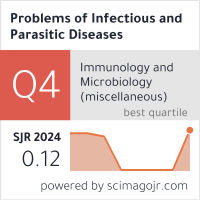AN ACUTE GASTROENTERITIS OUTBREAK IN A KINDERGARTEN
DOI:
https://doi.org/10.58395/w2hyet07Keywords:
multiplex RT-PCR, sequencing, epidemic outbreakAbstract
Objective: To detect the etiological cause of an acute gastroenteritis outbreak at St. Anna kindergarten in the village of Resilovo, region Kyustendil.
Materials and Methods: A total of 22 faecal specimens from children (n = 18) and staff (n = 4) were tested. Multiplex RT-PCR with specific primer pairs detecting the most common viral causes of gastroenteritis (noroviruses, rotaviruses, sapoviruses, intestinal adenoviruses and intestinal astroviruses) was applied to detect the viral causative agent. Noroviruses were detected and sequenced and subsequent phylogenetic analysis was carried out.
Results: Genogroup II noroviruses were detected in five samples from children and one sample from staff (6/22) or in 27.3% of the specimens. According to WHO criteria, this proves that noroviruses have caused the epidemic outbreak. Detected noroviruses were subjected to sequencing and subsequent phylogenetic analysis, with data identifying genotype 17 (GII.17) as the causative agent.
Conclusion: Norovirus genotype 17 (GII.17) was first detected in Bulgaria in 2015 as the causative agent of an outbreak in a secondary school in the town of Pravets. In 2016, the circulation of this genotype was again established in sporadic cases, and in 2022 it was found to be the cause of the epidemic gastroenteritis outbreak in a kindergarten in the village of Resilovo. To protect public health, continuous monitoring and targeted search for viral intestinal agents is essential, regardless of the transient and usually mild course of the disease.
Downloads
References
1. https://www.who.int/news-room/fact-sheets/detail/the-top-10-causes-of-death (accessed November 2nd, 2023)
2. https://www.cdc.gov/norovirus/burden.html
3. Jiang, X.; Wang, M.; Wang, K.; Estes, M.K. Sequence and Genomic Organization of Norwalk Virus. Virol 1993;195:51–61. http://doi.org/10.1006/viro.1993.1345
4. Thorne, L.G.; Goodfellow, I.G. Norovirus Gene Expression and Replication. J. Gen. Virol. 2014;95:278–291. http://doi.org/10.1099/vir.0.059634-0
5. Chhabra, P.; de Graaf, M.; Parra, G.I.; Chan, M.C.; Green, K.; Martella, V.; Wang, Q.; White, P.E.; Katayama, K.; Vennema, H.; et al. Updated classification of norovirus genogroups and genotypes. J. Gen. Virol. 2019;100:1393–1406. http://doi.org/10.1099/jgv.0.001318
6. Thongprachum A, Khamrin P, Pham NT, Takanashi S, Okitsu S, Shimizu H, Maneekarn N, Hayakawa S, Ushijima H. Multiplex RT-PCR for rapid detection of viruses commonly causing diarrhea in pediatric patients J Med Virol 2017;89: 818-824. http://doi.org/10.1002/jmv.24711
7. Yan H, Nguyen TA, Phan TG, Okitsu S, Li Y, Ushijima H. Development of RT-multiplex PCR assay for detection of adenovirus and group A and C rotaviruses in diarrheal fecal specimens from children in China. Kansenshogaku zasshi 2004;78:699-709. kansenshogakuzasshi1970.78.699, http://doi.org/10.11150/
8. Finkbeiner SR, Kirkwood CD, Wang D. Complete genome sequence of a highly divergent astrovirus isolated from a child with acute diarrhea. Virol J.2008;5: 117. http://doi.org/10.1186/1743-422X-5-117
9. Yan H, Yagyu F, Okitsu S, Nishio O, Ushijima H. Detection of norovirus (GI, GII), sapovirus and astrovirus in fecal samples using reverse transcription single-round multiplex PCR. J Virol Methods 2003;114: 37-44. http://doi.org/10.1016/j.jviromet.2003.08.009
10. http://www.mbio.ncsu.edu/BioEdit/bioedit.html
11. Kroneman A, Vennema H, Deforche K, v d Avoort H, Penaranda S, Oberste MS, et al. An automated genotyping tool for enteroviruses and noroviruses. J Clin Virol. 2011;51(2):121-125. http://doi.org/10.1016/j.jcv.2011.03.006 http://www.rivm.nl/mpf/norovirus/typingtool
12. https://blast.ncbi.nlm.nih.gov/Blast.cgi?PROGRAM=tblastn&PAGE_TYPE=BlastSearch&LINK_LOC=blasthome
13. Tamura K, Stecher G, Kumar S. MEGA11: Molecular Evolutionary Genetics Analysis version 11.0 Mol.Biol. Evol.2021;38(7):3022–3027. http://doi.org/10.1093/molbev/msab120
14. https://www.cdc.gov/norovirus/outbreaks/responding.html
15. Rackoff LA, Bok K, Green KY, Kapikian AZ. Epidemiology and evolution of rotaviruses and noroviruses from an archival WHO Global Study in Children (1976-79) with implications for vaccine design. PLoS One. 2013;8(3):e59394. http://doi.org/10.1371/journal.pone.0059394
16. Fu J, Ai J, Jin M, Jiang C, Zhang J, Shi C, et al. Emergence of a new GII.17 norovirus variant in patients with acute gastroenteritis in Jiangsu, China, September 2014 to March 2015. Euro Surveill. 2015;20(24):21157. http://doi.org/10.2807/1560-7917.es2015.20.24.21157
17. Lu J, Sun L, Fang L, Yang F, Mo Y, Lao J, et al. Gastroenteritis Outbreaks Caused by Norovirus GII.17, Guangdong Province, China, 2014-2015. Emerg Infect Dis. 2015;21(7):1240-1242. http://doi.org/10.3201/eid2107.150226
18. Matsushima Y, Ishikawa M, Shimizu T, Komane A, Kasuo S, Shinohara M, et al. Genetic analyses of GII.17 norovirus strains in diarrheal disease outbreaks from December 2014 to March 2015 in Japan reveal a novel polymerase sequence and amino acid substitutions in the capsid region. Euro Surveill. 2015;20(26):21173. http://doi.org/10.2807/1560-7917.es2015.20.26.21173
19. Medici MC, Tummolo F, Calderaro A, Chironna M, Giammanco GM, De Grazia S, et al. Identification of the novel Kawasaki 2014 GII.17 human norovirus strain in Italy, 2015. Euro Surveill. 2015;20(35):30010. http://doi.org/10.2807/1560-7917.ES.2015.20.35.30010
20. Dinu S, Nagy M, Negru D, Popovici E, Zota L, Oprișan G. Molecular identification of emergent GII.P17-GII.17 norovirus genotype, Romania, 2015. Euro Surveill. 2016;21(7):30141. http://doi.org/10.2807/1560-7917.ES.2016.21.7.30141
21. de Graaf M, van Beek J, Vennema H, Podkolzin AT, Hewitt J, Bucardo F, et al. Emergence of a novel GII.17 norovirus – End of the GII.4 era? Euro Surveill. 2015;20(26):21178. http://doi.org/10.2807/1560-7917.es2015.20.26.21178
Downloads
Published
Issue
Section
License
Copyright (c) 2024 Asya Stoyanova, Irina Georgieva, Metodi Popov, Rayna Saparevska, Lubomira Nikolaeva-Glomb (Author)

This work is licensed under a Creative Commons Attribution 4.0 International License.






